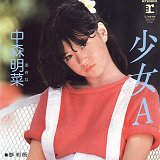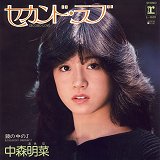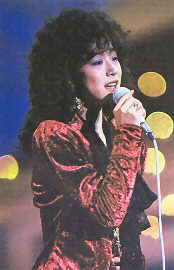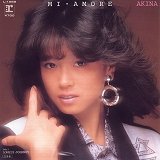 On July 1, 1982, Akina released her first album "Prologue" which was a success as more than
400,000 copies sold. A month later, her second single "Shojo A" went on sale.
The song, and the image of the rebellious young woman it conveyed, was the subject of some controversy
at the time. Despite--or perhaps in some measure due to--this, the single was a success and marked Akina's
arrival to the ORICON top 10. In fact, the song would peak at 5th on the chart. The success of the song led
to an appearance on TV's "The Best Ten," which further served to reinforce Akina's growing popularity as a
teen idol.
On July 1, 1982, Akina released her first album "Prologue" which was a success as more than
400,000 copies sold. A month later, her second single "Shojo A" went on sale.
The song, and the image of the rebellious young woman it conveyed, was the subject of some controversy
at the time. Despite--or perhaps in some measure due to--this, the single was a success and marked Akina's
arrival to the ORICON top 10. In fact, the song would peak at 5th on the chart. The success of the song led
to an appearance on TV's "The Best Ten," which further served to reinforce Akina's growing popularity as a
teen idol.
 In November, 1982, Akina's third single "Second Love" was released and was an immense success reaching
number 1 on the ORICON chart. It remains as Akina's highest selling single to date, with over 1,000,000
copies sold.
In November, 1982, Akina's third single "Second Love" was released and was an immense success reaching
number 1 on the ORICON chart. It remains as Akina's highest selling single to date, with over 1,000,000
copies sold.
Beginning with "Shojo A," Akina began a string of No. 1 hits that would catapult her to superstar status. By 1983, Akina had established herself as a top-selling artist with a combined (singles and albums) annual sales of 8 billion yen (roughly equivalent to 32 million dollars at the time).
Akina's tremendous popularity, as reflected by her consistently high rankings on the music charts, was further confirmed by her weekly performances on popular televised ranking shows such as "The Best Ten" (TBS) and "Uta no Top Ten" (NTV), as well as regular guest appearances on musical showcase programs such as Fuji TV's "Yoru no Hit Studio Deluxe."
 On December 31, 1983, Akina appeared for the first time on NHK's Kouhaku Utagassen (the famous Red
and White Singing Contest). With her performance of "Kinku" that year, she made the first of six
consecutive Kouhaku appearances from 1983 to 1988.
On December 31, 1983, Akina appeared for the first time on NHK's Kouhaku Utagassen (the famous Red
and White Singing Contest). With her performance of "Kinku" that year, she made the first of six
consecutive Kouhaku appearances from 1983 to 1988.
In 1985, Akina was cast to play the part of a young woman dying from a heart ailment in the motion picture "Ai Tabidachi." The film co-starred Kondo Masahiko (aka "Matchy") as her ne'er-do-well boyfriend (Kondo had become her real-life boyfriend as well). The movie, which did well at the box office, would prove to be Akina's first significant step toward expanding her career to include acting.
 Later that year, at the age of 20, Akina won the highly coveted Record Taisho Grand Prize for "Meu Amor é...".
This came as a great surprise to many people; as an idol singer, Akina was considered to be far
too young to receive such a high honor. Indeed, no singer that young had ever won previously.
Later that year, at the age of 20, Akina won the highly coveted Record Taisho Grand Prize for "Meu Amor é...".
This came as a great surprise to many people; as an idol singer, Akina was considered to be far
too young to receive such a high honor. Indeed, no singer that young had ever won previously.
In 1986, Akina would prove that her win the previous year was no fluke. She claimed the Record Taisho Grand Prize for a second straight year with the smash hit, "Desire". In doing so, she became only the second singer to win the award twice (Hosokawa Takashi was the first) and the first to achieve it in consecutive years.
![]() That same year, Akina won the Gold Disc Taisho, awarded to the artist achieving the highest
total record sales—a further testament to the tremendous selling power she had attained by the
mid 1980's.
That same year, Akina won the Gold Disc Taisho, awarded to the artist achieving the highest
total record sales—a further testament to the tremendous selling power she had attained by the
mid 1980's.
The single "Nanpasen," composed by Kato Tokiko, was released the following year. Akina's stirring performances of "Nanpasen" could easily have earned her a third consecutive Record Taisho honor. The song, which dealt with separation in love, would prove to be a particularly poignant theme for Akina.
1987 was a significant year for Akina in another way. The concurrent release of her English-language album, "Cross My Palm," under the Reprise (in Japan) and Atlantic (in the U.S.) labels, signaled an all-out attempt to fashion Akina into an international artist. Although the album ultimately did not make a major impact in the U.S. market, the fact that Warner-Pioneer had backed the venture in earnest demonstrated just how great Akina's star power had become.
 In contrast to the prototypical JPop idol of the 1980's, Akina displayed exceptional depth and versatility in
her singing style. She openly expressed her opinions regarding the music written for her, and in
doing so, gained the respect of composers and lyricists, who came to view her not just as an idol
singer, but as a serious artist.
In contrast to the prototypical JPop idol of the 1980's, Akina displayed exceptional depth and versatility in
her singing style. She openly expressed her opinions regarding the music written for her, and in
doing so, gained the respect of composers and lyricists, who came to view her not just as an idol
singer, but as a serious artist.
 Throughout the 1980's, Akina was backed by a number of well-known composers including Kisugi Takao
("Slow Motion," "Second Love," "Twilight"), Serizawa Hiroaki, ("Shojo A"), Osawa Yoshiyuki
("1/2 no Shinwa"), Hosono Haruomi ("Kinku"), Hayashi Tetsuji ("Kita Wing"), Tamaki Koji
("Southern Wind"), Takanaka Masayoshi ("Jukkai"), Inoue Yosui ("Kazarijanainoyo Namidawa"),
Matsuoka Naoya ("Meu Amor é..."), Tsushimi Takashi ("Sand Beige") and Takekawa Yukihide ("Solitude").
Throughout the 1980's, Akina was backed by a number of well-known composers including Kisugi Takao
("Slow Motion," "Second Love," "Twilight"), Serizawa Hiroaki, ("Shojo A"), Osawa Yoshiyuki
("1/2 no Shinwa"), Hosono Haruomi ("Kinku"), Hayashi Tetsuji ("Kita Wing"), Tamaki Koji
("Southern Wind"), Takanaka Masayoshi ("Jukkai"), Inoue Yosui ("Kazarijanainoyo Namidawa"),
Matsuoka Naoya ("Meu Amor é..."), Tsushimi Takashi ("Sand Beige") and Takekawa Yukihide ("Solitude").
In addition to best-selling hits and musical achievements, Akina would also become widely known for her visually-stunning fashions (a number of which she herself designed) and graceful on-stage movements. Akina's early ballet influence was made evident as she choreographed the dance steps that accompanied many of her performances.